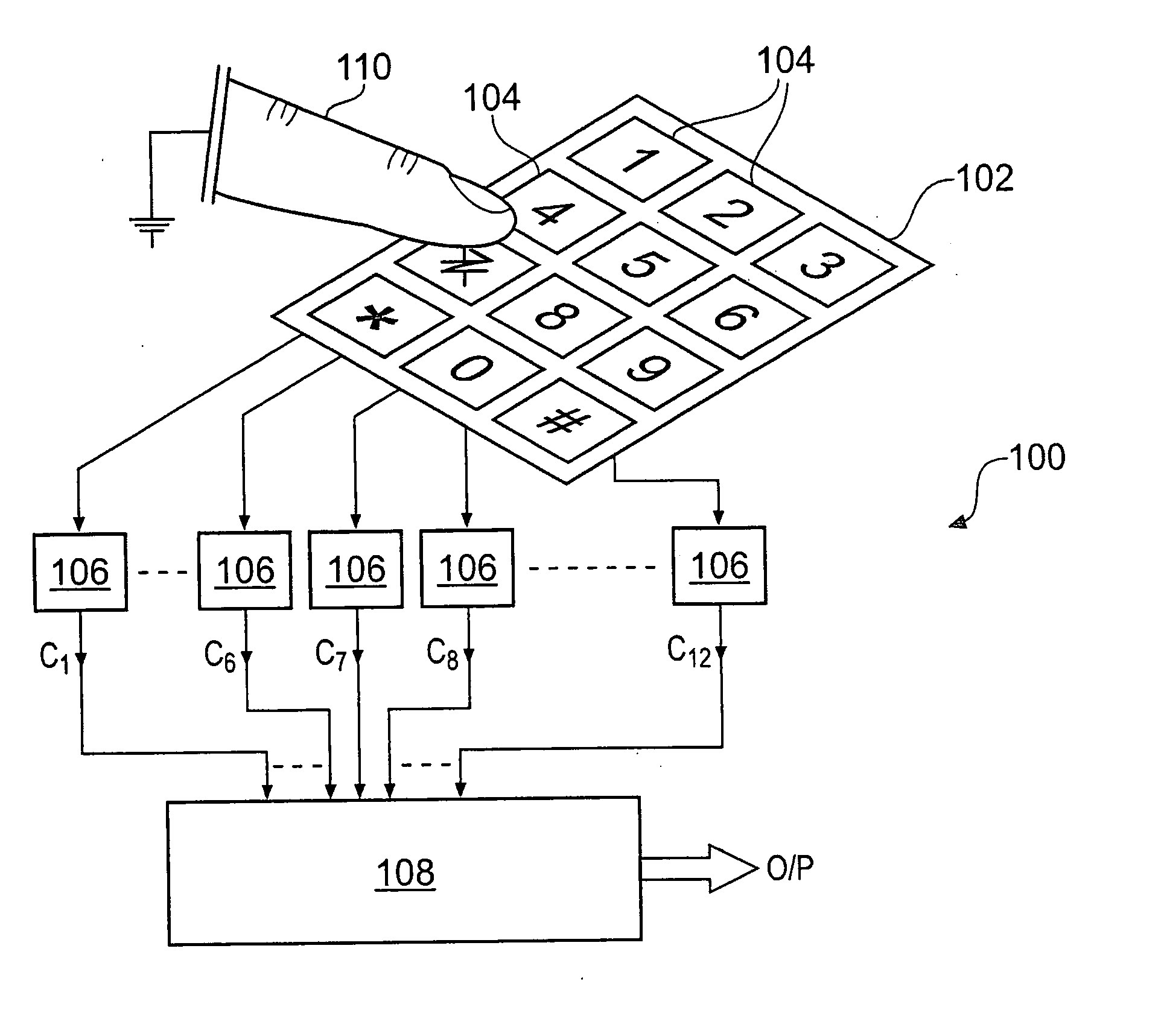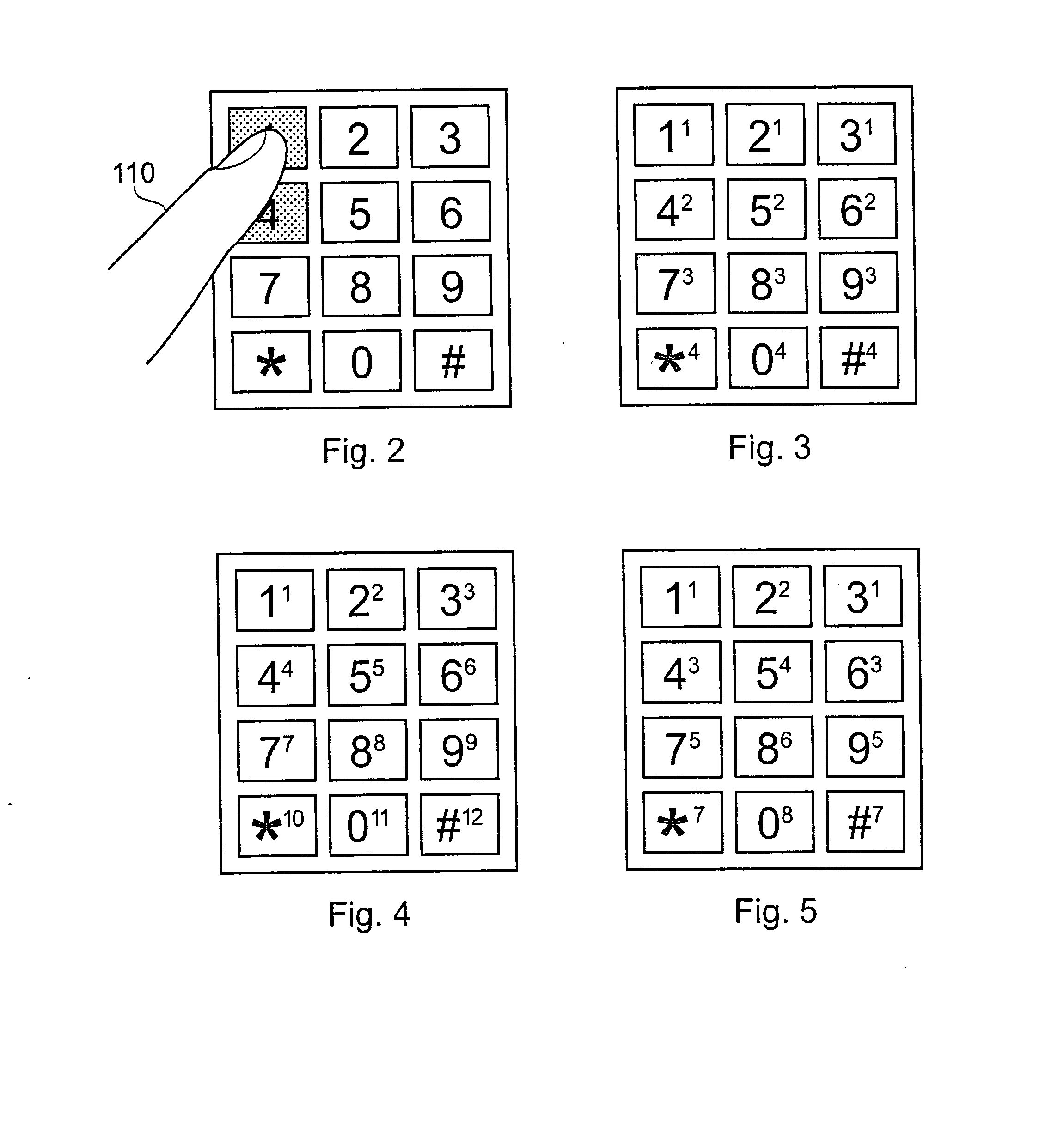[0012] By taking account of the positions of sensing areas within the sensing region as well as their associated output signals, the controller is able to more reliably determine which one of a plurality of sensing areas (keys) in a sensing region (keypad / keyboard) in simultaneous detection is intended by a user for selection. This is because the controller may be configured to take account of which keys in a keypad are more likely to be wrongly selected as being intended by a user by virtue of their positions, in particular with respect to the orientation of the pointing object. For example, in a keypad in which a pointing object normally passes over a given key or keys when a user selects a desired key, the controller can in effect suppress signals from the non-user selected keys over which the pointing object passes based on their positions.
[0015] Alternatively, the
ranking scheme may be such that the controller is arranged to determine the selected one of the sensing areas by applying
a weighting to the output signals according to the positions of the corresponding sensing areas in the sensing region. The weighting may be applied by scaling the output signals by a scale factor associated with the corresponding sensing areas so that sensing areas associated with higher scale factors are preferentially selected over sensing areas having lower scale factors. This has the
advantage of allowing an activated key having a lower
ranking than another activated key to still be selected if its output
signal is sufficiently high, that is to say, a sufficiently high output
signal can overcome a lower
ranking. This can help, for example, if there is a concern that complete “block out” of the lowest ranked key(s) might otherwise occur.
[0016] The controller may be operable to take account of the positions of the sensing areas within the sensing region when determining the selected one of the sensing areas by preferentially selecting sensing areas having positions nearer to predefined parts of the sensing region over sensing areas having positions farther from the predefined parts of the sensing region. For example, the predefined parts of the sensing region may be parts that are furthest from the user along a direction in which a pointing object approaches the screen. This in effect suppresses the sensing areas in parts of the sensing region that the pointing object passes over when a user wished to select a sensing area in one of the predefined parts of the sensing region (e.g. a top row, or a top corner) of the sensing region.
[0025] One aspect of the invention is that it may provide a method of removing
keying ambiguity by measuring a detected
signal associated with each key in an array, comparing the measured signals, determining that an upper key having a signal in relation to a lower key signal is the
unique user-selected key, and maintaining that selection until either the upper key's
signal strength drops below some threshold level or a second key's
signal strength exceeds the upper key's
signal strength. When an upper key and a lower key are pressed by a user, the upper key is preferentially selected and its signal strength value may be enhanced relative to the other key(s) so as to deselect the other key(s). In this aspect, the array under consideration may be a keyboard, or any convenient subset thereof.
[0026] The present invention provides an improvement over U.S. Pat. No. 6,466,036 and U.S. application Ser. No. 11 / 279,402 (published as US 2006-0192690 A1) in that an upper key of a keypad can be preferentially selected over a lower key or keys even if the signal from the upper key is weaker than the signal from the lower key or keys. This is particularly advantageous for small keyboards or keypads, like mobile phones which are becoming increasingly smaller in size with improvements in technology and due to
consumer demand requiring ever more miniature and ‘slim’ handsets. With small mobile handsets the keys can be spaced very closely together which means that it is difficult to press the intended keys, especially if the user has large fingers. Often a user may accidentally press more than one key at the same time including the intended key the user wished to select. The invention allows an upper key to be selected by suppressing the signal from other adjacent keys that may also have been pressed or from which
capacitive coupling may have been detected, as the upper key is often the intended key of the user.
[0028] U.S. Ser. No. 11 / 279,402 (published as US 2006-0192690 A1) discloses an embodiment with an array of capacitive keys in which each key has a respective detection
integrator counter (DI) associated with it. Each DI is a clocked counter that counts up by one incremental value on each capacitive acquisition cycle during which a signal strength from the associated key is above some nominal threshold value, and that counts down toward zero if the signal strength is less than the nominal value. A controller receives a respective input from each DI and determines that one of the keys is selected, e.g., wins, when the detection integration (DI) count associated with that key meets a respectively selected terminal count value, TC. The incremental magnitude used for counting down can be the same as that for counting up, e.g., 1, or it can be different, e.g., 2, to preferentially accelerate the count-down ‘losing’ process over the winning process, in order to facilitate better suppression of
noise. The rate of counting down any of the DI counters can also be the complete value, i.e., the DI can be cleared in one cycle. In this embodiment, when two or more keys have signal strengths above their nominal thresholds, the key with the lesser signal strength will have its associated DI decremented or cleared each cycle while this condition exists. If any two or more keys have equal and maximal signal strengths, such keys' DI's will continue to increment until the first to reach its TC ‘wins’ and is set as the
unique user-selected key.
 Login to View More
Login to View More  Login to View More
Login to View More 


